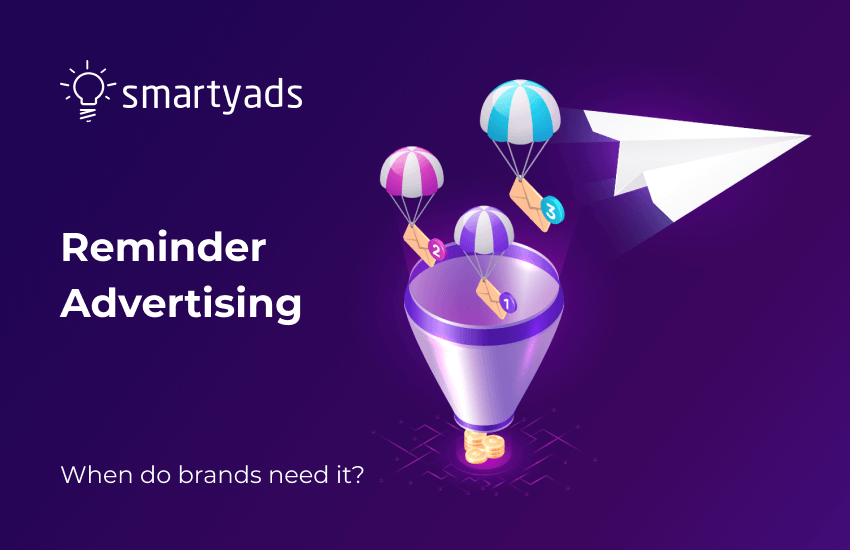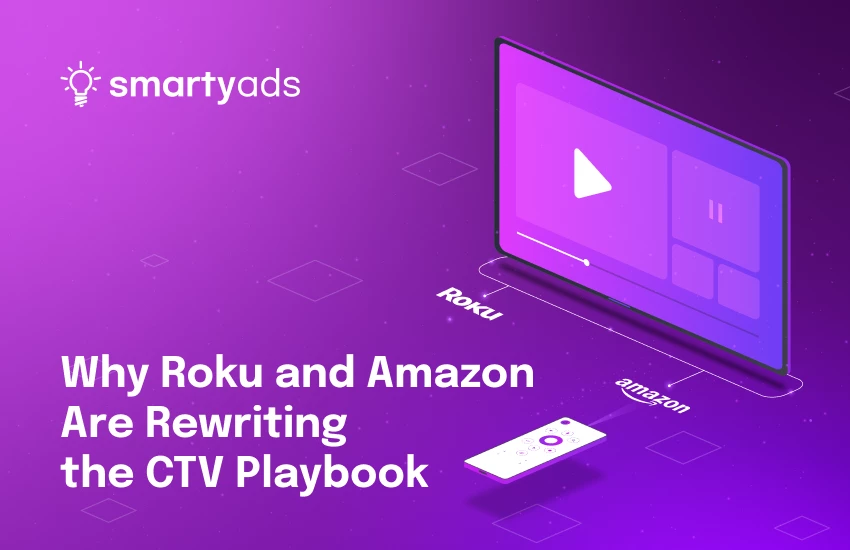Publishers are massively transitioning to header-bidding (parallel bidding) – a technology already well-established in the desktop environment. Header-bidding allowed website owners to compare the incoming bids from DSPs in mutually beneficial unified auctions.
Still, due to the difficulty of implementation, in-app header-bidding fell behind desktop in terms of mobile app monetization models. Today, the massive transformation has finally hit mobile devices. In this regard, the majority of publishers are puzzled by the question: which of the monetization mechanisms works best for mobile web in 2024: implementing SDK mobile advertising, in-app header bidding wrappers, or in-app purchases IAP?

Why is mobile app monetization important?
What are mobile app monetization models in the first place? You should know them, especially when you are wondering how to launch a mobile app. They are a set of methods that enable the publisher/app developer to achieve a speedy stream of income generated by their app. These methods are different, starting from advertising and ending with in-app purchases (IAP). Some apps use a subscription-based payment model, and so on. Monetizing an application is crucial for various reasons.
Sustain development and support
Monetization ensures a steady stream of income, which can be reinvested into the application's development, maintenance, and customer support. This sustains the growth of it and allows for continuous improvement.
Quality Enhancement
Revenue from monetization can fund research and development, allowing for the implementation of new features, enhancements, and updates. This improves the overall quality and user experience of the application, keeping it competitive in the market.
Resource Allocation
A correctly chosen mobile ad monetization strategy helps allocate resources effectively. It provides insights into which features or aspects are most valued by users, allowing developers to prioritize resources accordingly. This optimizes efforts towards areas that generate the most revenue or user engagement.
Scaling Operations
With a reliable revenue stream, developers can scale their operations. This includes expanding the team, investing in infrastructure, and exploring new markets or platforms. Scaling operations enable the app to handle increased user traffic and maintain performance.
Mobile app monetization 2024: IAP and advertising
In 2023, game revenues have reached $92.6 billion on mobile platforms. A review of the most profitable apps has shown that mobile games, AR and hypercasual in particular, are remaining to be the leaders in the in-game purchasing segment.
In the US, for instance, the market of subscription-based gaming market size is supposed to reach billions by the end of 2030. A large part of it will be attributed to mobile.
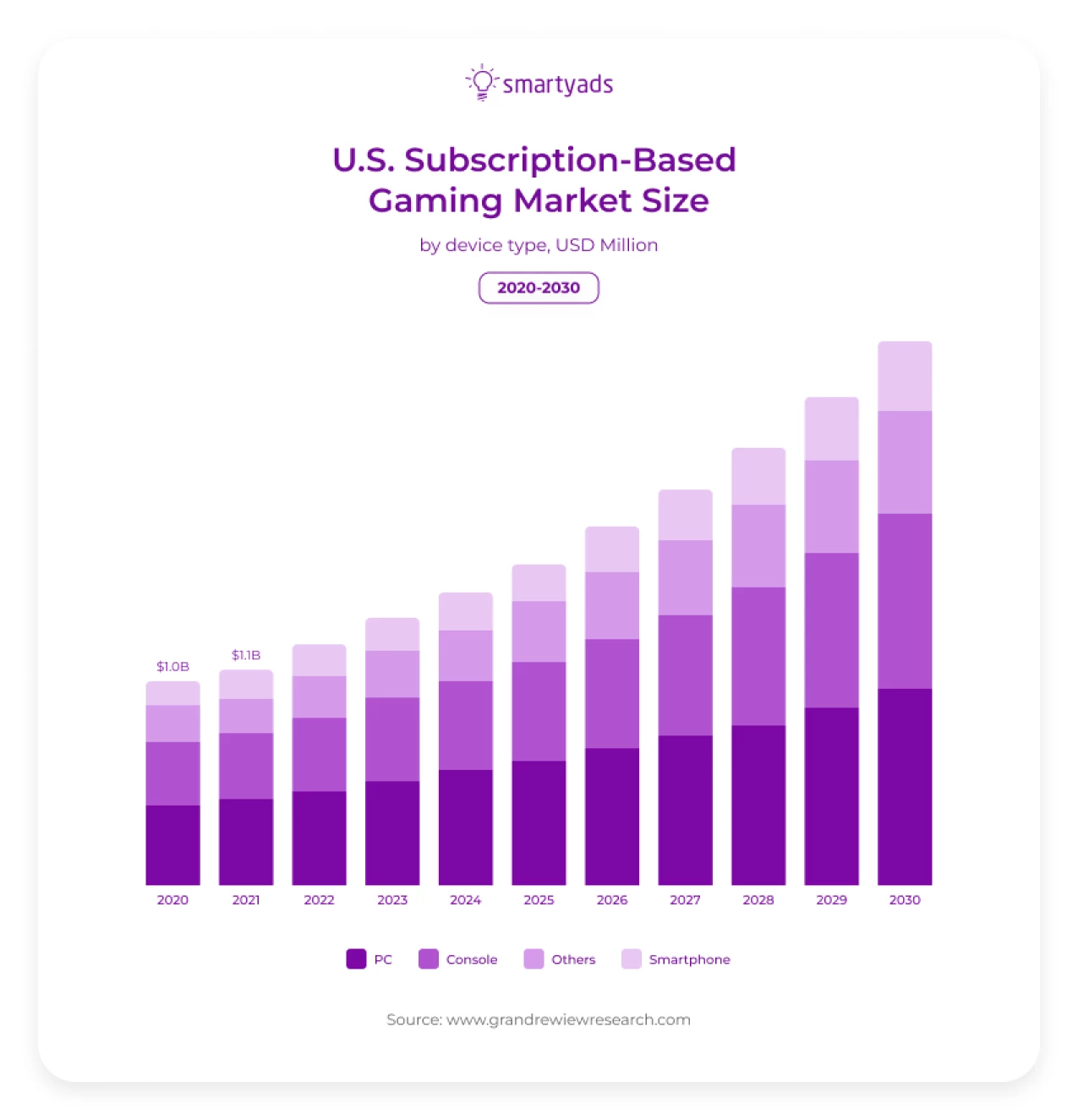
The role-playing games and strategies mainly focus on monetization via in-game purchases.
In apps where user engagement and game skills can be low, like those in the hyper-casual genre, advertising is chosen as a primary mobile app monetization strategy enabled by in-app bidding and other programmatic auction types. With increasing involvement and skill, mobile advertising can be substituted with in-app purchases.
For the free apps, ad placements are the only source of income that helps to keep the mobile game free for users. For instance, downloading the horror ‘Granny’ game is free on the App Store and Play Market, but in the process, it asks to collect user data to enable targeted advertising. Same thing with non-gaming apps: Spotify, Facebook, or Twitter. In such cases, this model works exceptionally effectively – in fact, APs generate 48.2% of total earnings.
Interactive advertising campaigns: rewarded and playable
In the US, the average user income from rewarded video ads is $0.02 per impression (stats are legit for the US market).
The stars of interactive ad formats are, undoubtedly, rewarded and playable video ads. Rewarded video is a commercial that a user voluntarily watches in return for a reward: free game bonuses, options, or access to exclusive content. This model has been introduced during the last couple of years. After trying this one, developers who rely entirely on in-game purchases are gradually rethinking their monetization strategies.
The thing is, playables are not only the best eCPM generators ($30 compared to $0.15-$2.00 banners), but they’re also user-oriented and preferred by 70% of mobile gamers, which enhances web to app user acquisition and LTV.

Playable videos, in their turn, show eight times better ad unit performance than other ad formats in general. These are the videos that pop up in the middle of the game and feature a demo version of the other game, which users can try before downloading. When the technology is ready, interactive ad formats will also be available on CTV platforms, which will add even more engagement to the immersive big-screen TV experience.
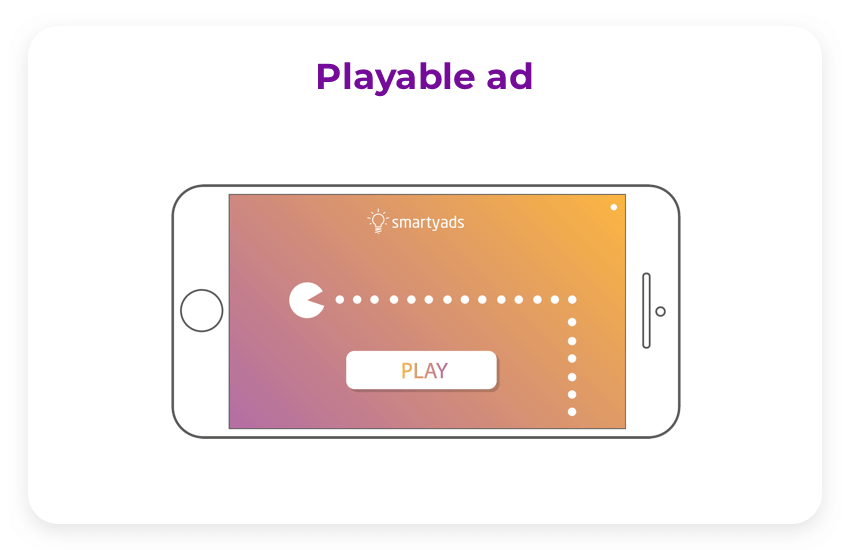
Mobile app monetization options
Now let’s review some of the most popular options for making your app profitable, namely, what is beneficial in SDK advertising and what is in app header bidding.
What is SDK monetization?
Picture your mobile app as a bustling marketplace full of vendors. These vendors, in the form of SDKs (Software Development Kits), offer tools and services such as displaying ads, managing in-app purchases, or providing analytics. In return, you receive a share of the revenue generated through these activities.
In terms of main features, SDK encompasses various functionalities. These include ad integration, allowing you to display ads from different networks; analytics, providing insights into user engagement and ad performance; in-app purchases, enabling you to offer additional content or features for sale within your app; and user authentication, ensuring the security of user accounts and personalized experiences.
Pros: By integrating different SDKs, you're not putting all your eggs in one basket. You can tailor the strategy to fit your app's unique needs and target audience. App monetization strategies enabled by SDKs are convenient. The installation of DSK is typically straightforward, with many providers offering documentation and support to assist developers. Plus, these tools offer valuable insights into user behavior and ad performance, empowering you to make informed decisions to enhance your app's revenue potential.
Cons: However, there are some considerations to keep in mind. Integrating multiple SDKs can increase the weight of your application, potentially impacting its performance and user experience. Managing and maintaining these integrations can also become complex over time. Moreover, your app's dependency on third-party SDK providers means you're reliant on them to keep their tools updated and functioning properly.
What is in-app header bidding?
Imagine your app's ad space as prime real estate. Mobile header bidding or in-app one is like holding an auction where multiple advertisers compete in real-time to secure that space before an ad is served to the user. In other words, it is the same unified auction as you know it on desktop, only this time it takes place on mobile.
In terms of main features, in-app header bidding primarily involves real-time bidding, where advertisers bid instantly for your ad space; transparent pricing, providing clarity on the value of each ad impression; faster loading times for ads, enhancing user experience; and access to premium ads, attracting high-paying advertisers.
Pros: It increases competition among advertisers, driving up the value of your ad inventory and ultimately boosting your revenue. With transparent pricing, you know exactly what each ad space is worth, giving you greater control and visibility into your monetization strategy. Moreover, since auctions happen simultaneously, there's less delay in serving ads, leading to a smoother user experience. Additionally, app monetization models like in-app header bidding grants publishers access to premium demand sources, including direct deals and high-paying programmatic buyers.
Cons: It requires technical expertise to set up and manage implementation effectively. There's also the possibility that integrating additional functionalities could increase the size of your app, potentially affecting its performance. Ensuring the quality and safety of the ads shown is crucial, as is navigating any revenue-sharing agreements with the platforms facilitating the header bidding process.
Header-bidding mobile app monetization for publishers
So, what is in-app bidding? For a long time, publishers run mobile in-app monetization using Waterfall. Publishers were sending their requests to third-party platforms, which sequentially offered mobile advertising networks to the publishers in return. The first mobile ad network obtained the right to send the bid, and only if it could match the publisher’s floor price the second network could respond to the request. Each subsequent Waterfall round decreased the price of inventory.
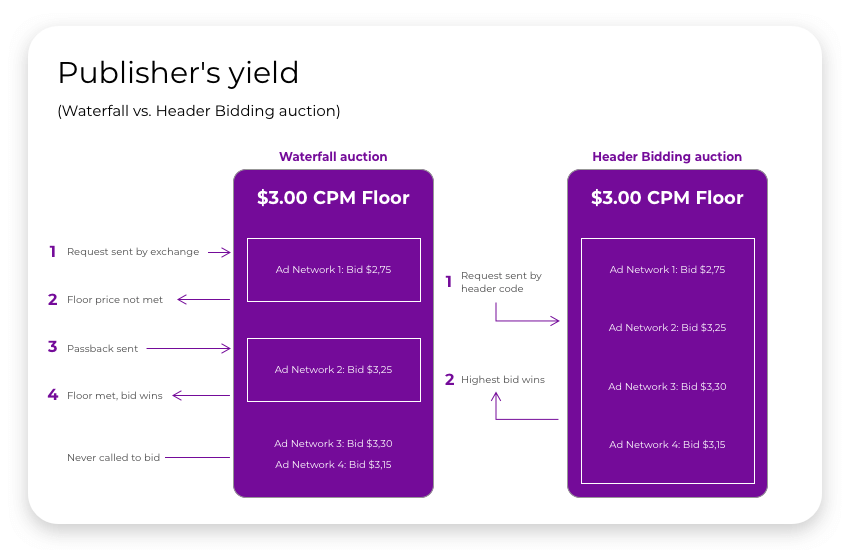
As featured above in the picture, header-bidding effectively resolves these problems, providing advertisers with equal right to get the best inventory quality and saving the publishers from potential profit gaps. As a result, application profitability rises, according to various estimates, by 30–50%. How to monetize a free app with this method? It becomes possible thanks to ad platforms like DSPs or trading desks.
The unified auction allows DSPs and trading desks, which represent a big share of the demand, to compete for inventory side-by-side with advertising networks. Header-bidding app monetization solution provides developers with an opportunity to report on the price of each impression, and, unlike waterfall, it features no additional commissions or biases in favor of certain demand parties. Now, there’s another good news for advertisers. IAB Tech Lab has also launched ads.txt specification version 1.0.2 designed specifically for in-app and OTT inventory authorization which promises to make mobile programmatic media buying more transparent and safe. To get ads.txt explained, read our previous article as well.
Implementation. Since header-bidding is a string of JavaScript code embedded in the website’s header, the same way it is implemented in mobile websites. As there’s no browser in the application, the app developers install SDKs (software development kits) - a variation of plugins written in the language of app’s OS (IOS or Android) and integrated to perform certain functionality. SDK is responsible for initiating the header bidding and inviting demand partners to the unified auction. Currently, in-app header bidding is supported by Prebid.js, Direct Bidder, and FairBid.
Note: Several SDKs integrated into the single app can slow down the app and increase the likelihood of problems associated with latency. To avoid this, many enterprises implement server-side header bidding, where server to server connections are handling a great deal of the workload so that loading speed in apps significantly increases.
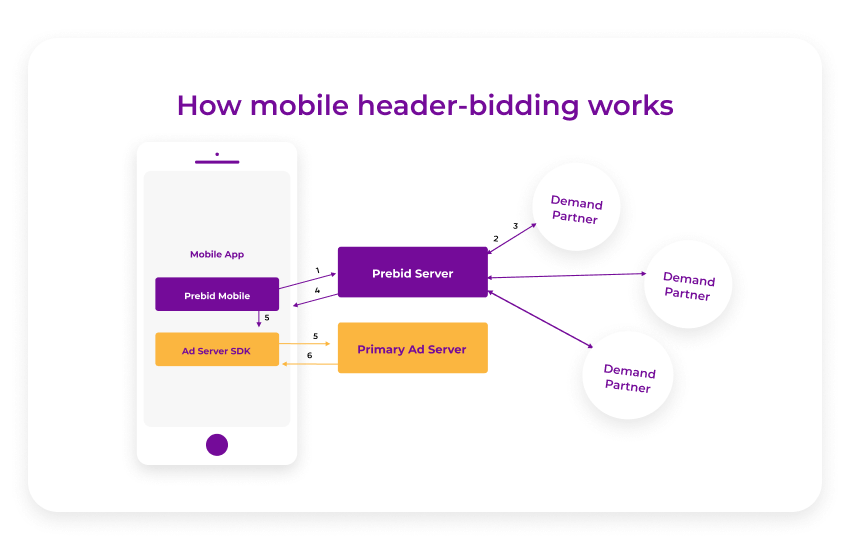
In-app header bidding vs. SDK monetization
The practice proves the following: Every publisher today works with at least five different partners. To this day, the market has been advocating for SDK mediation solutions. These solutions enable app publishers and developers to manage the networks using a single SDK that acts as a container for others.
With several SDKs grouped together, publishers get all the benefits each SDK partner offers, but again, they can be limited to whatever the mediation network supports. Apart from this, more manual work might be needed to configure each network and make it work well for the app.
Hader-bidding helps to reduce the necessity of SDK implementation since the solution already provides access to a large number of demand partners. So, how to monetize an app with it?
The transition from SDK mediation to the header-bidding auction can be implemented via prebid mobile. In this case, all that the publisher has to do is install the prebid mobile SDK, which will send the call to the prebid server, which supports server-side auctions. The app’s primary ad server (also must be installed) will receive the creative of the auction winner.
| Comparison Point | In-App Header Bidding | SDK Monetization
|
| Revenue Potential | Maximizes publisher income by accepting multiple bids simultaneously. | Limited to one bid per ad placement, potentially reducing revenue.
|
Installation
| More technically complex than SDK. | Fairly simple and straightforward when working with one partner. Adding multiple SDKs requires more efforts than in-app monetization. |
| Latency | Reduces latency by consolidating bid requests and responses. | Increases latency with each additional SDK integration.
|
Transparency
| Provides clear insight into all incoming bids, ensuring transparency.
| Limited visibility into individual SDK bid processes. |
Partner Management
| Offers better control over inventory and partner management through wrappers.
| Managing multiple SDK partners separately can be challenging. |
| Compatibility | Monetization of apps is convenient on different platforms due to standardized protocols.
| Compatibility issues may arise with different app environments. |
Considerations – when to choose each? So, should I monetize my app with DSK or in-app header bidding? You may ask this question yourself. Things is, both methods have their own set of advantages and drawbacks. In-app header bidding shines in terms of revenue potential, latency reduction, transparency, development simplicity, partner management, and app compatibility.
However, SDK still holds its ground, particularly in situations where specific partner requirements or existing integrations are prioritized. For instance, if top priority is revenue boosting, then in-app header bidding's ability to accept multiple bids simultaneously can lead to higher overall earnings compared to SDK, so the choice is obvious.
At the same time, publishers with existing partnerships or integrations with specific SDKs may find it more convenient to stick with SDK to avoid disrupting established relationships or workflows.
The last word
How to monetize mobile apps in 2024? There are several options, starting from lightweight SDKs and ending with ultimately profitable app header-bidding auctions. Each of these options can provide its unique sets of benefits, and in order to make the right choice, publishers need to determine what they prioritize most. Additionally, many publishers use a combo of all these techniques while achieving increased application profitability, saving valuable partner integrations, and enhancing mobile app monetization metrics.
Generate income immediately after header-bidding implementation. Contact us to find out how!




